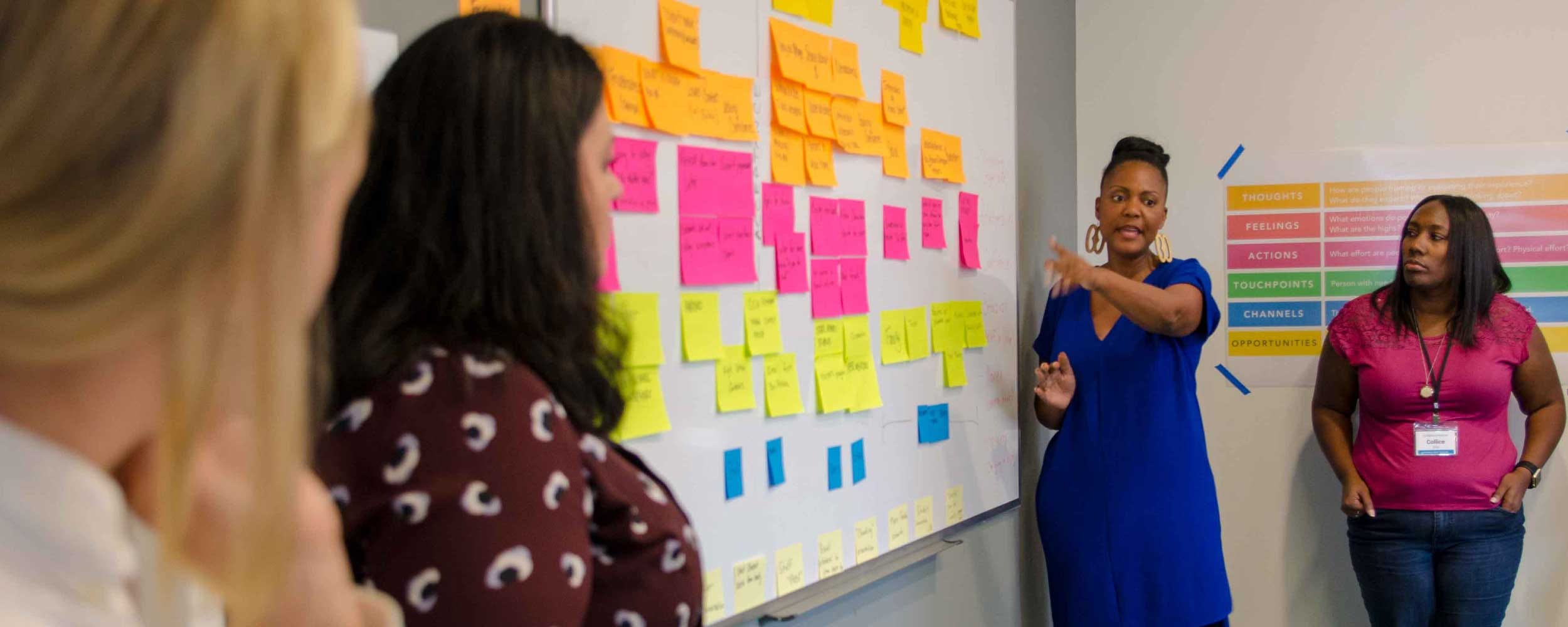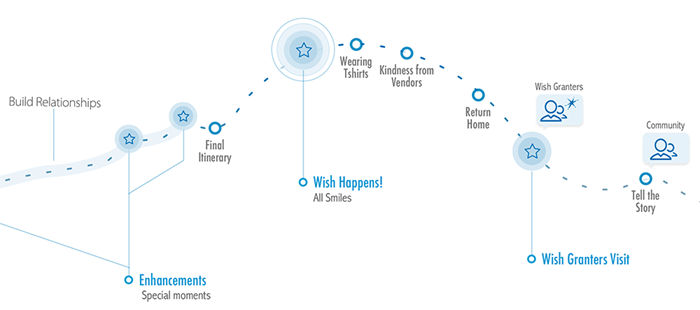This is an original article written by Jon Berbaum, President of Highland Solutions.

As a business or technology leader, you’re probably aware of the supposed virtues of “design thinking” these days. In my unofficial metric, it may soon surpass “digital transformation” or even “agile transformation” as the business strategy du jour.
But what do we actually mean when we say design thinking?
Design thinking describes the practice of using cross-functional teams and creative processes to drive innovation. It is a close cousin of human-centered design, which is the conviction that the best solutions are rooted in making things useful, usable, and even delightful for the people using or experiencing them.
But Is Design Thinking Useful?
It’s a worthwhile question to ask, particularly if you’re working at an established organization that has succeeded without “design thinking” for decades. At Highland, we are avid practitioners of design thinking, and we’ve seen the impact it can have on enterprise-level companies who are just starting to adopt these principles.
One strong piece of evidence for the utility of design thinking is our ongoing Design Thinking Roundtable. We regularly convene leaders of Fortune 500 companies, well-resourced nonprofits, and large government agencies who are applying design thinking to their established organizations. These leaders are going beyond the first step of partnering with design thinking and innovation firms like Highland and asking how they can build these competencies in-house.
If you’re also wondering where to get started with design thinking, here are three mindsets and three practices that, in my opinion, are the best places to start.
Three Critical Design Thinking Mindsets
These mindsets can help you solve problems through the lens of a design thinker, whether you’re using design thinking tools or not. The team at Highland has found these mindsets to be immensely valuable, and we encourage our teams to apply them to every project from CRM integration to OutSystems development.
1. Empathy
When is the last time you spoke with a customer at length about their experience with your firm? About what they hoped to accomplish by hiring your product or service?
It’s surprising how many weeks and months can go by without a team really talking, face to face, with a customer. Focus groups and NPS scores and satisfaction surveys typically ask customers for an opinion on how you are performing, often putting some digital intermediary like a survey form between them and the customer.
Don’t let some “middle survey vendor” get in the way. Instead, go talk to customers! Watch them interact with your product or service or people. Interview them and ask them to tell their stories, starting from when they first realized they needed the kind of thing your company provides until the end of their journey with you.
While you are listening to their trials and triumphs, you are developing empathy for their human experience of your customers and what they are trying to accomplish in their work or lives. This is the bedrock on which the rest of design thinking is built. The great news is you only have to talk to a few customers! Nielsen Norman Group, a leader in the user experience field, has published research that shows that speaking with groups of five customers in the same segment can provide nearly 80% of the feedback themes for a product, service, or experience that you would normally get from a much larger sample size.
2. Collaboration
I love this scene from Mad Men where Don Draper walks into a room and delivers a genius presentation to name the carousel.
This is the stereotype we have of the creative process: the genius with brilliant insight drops the solution ready-made into the business leader’s lap.
But Don just came up with a name for the carousel. The team that invented the carousel didn’t work that way, and it’s not possible to work that way.
Design thinking requires teams to work together. Like, in the same room most of the day together. This goes against the typical company culture of gathering for a meeting to determine status, assign to-do items, and then schedule the next time to check in. But if you want new or better products or services or experiences, your cross-functional teams need to get used to spending hours with each other to define, ideate, create, test, and iterate on possible solutions.
Design thinking practices offer lots of ways for teams to engage in solving challenges together, so you don’t have to reinvent the wheel. But, you might need to reset your company’s idea of what it looks like to work together.
3. Working at Speed
Design thinking usually incorporates artificially imposed deadlines that create the conditions for working at speed, helping design thinking teams commit to learning and experimentation. I have deep respect for David Hussman from DevJam and love his aphorism: “We call failing fast learning, and failing slow failure.”
It takes humility to acknowledge that we may not know if our new or improved solution will fix an issue, or if people will use it or buy it or like it. And it shouldn’t stop us from creating and trying new things.
Three Design Thinking Practices to Get Started
If you’re ready to try real design thinking practices on your own, there are a few simple ways to get started without bringing in consultants or vendors for support. Expert insight can of course add greater impact if an organization is full of skeptics, but you can also test them out with your team first and then call in the “big dogs.”
1. Jobs To Be Done
Jobs To Be Done is a framework for interviewing customers and prospects and understanding what they want to accomplish. Jobs Theory comes from Clayton Christensen at Harvard Business School and is most recently summarized in his book Competing Against Luck.
Clayton’s theory says if you want to create compelling products, services, or experiences, don’t focus on the demographics of your customers. Instead, identify the jobs your potential customers are hiring your product or service to do. These jobs can be:
- Functional: Accomplishing a task
- Emotional: Bolstering or assuaging a belief or feeling
- Social: Increasing human connection or social standing
To get started, go interview five customers who recently started or stopped using your company’s product or service. Ask them to tell the story of everything that was happening when they made their decision. What were they thinking? Why? Where were they? What emotions were they feeling? Think of it like filming a documentary of that “switching” moment, capturing all of the little details that make up the scene. Then, pull the themes out of those interviews onto this Value Proposition Canvas and rank them to get a picture of what jobs are most important to your customers.
2. Customer Journeys
Journey mapping helps organizations see themselves from their customers’ point of view. It helps teams develop an “outside in” perspective on the current reality of the experience they deliver, and it aligns people from throughout the organization with that experience. This exercise is ideal for organizations who are beginning (or considering beginning) a customer experience initiative.
We’ve done journey maps of various kinds and sizes, and our favorite get-started approach is an intense five-day setup that works like this:
Day 1: Planning, Research, and Sourcing
- Define the journey’s point of view.
- Create an “inside-out” experience map of the customer journey.
- Create personas and target interview list.
- Identify and schedule interviews with seven to ten participants. Local, face to face interviews or video interviews are preferred.
Days 2 and 3: Guided Storytelling Interviews
- Conduct 60–90 minute guided storytelling interviews.
- Transcribe interview notes into narratives.
- Collect existing data (survey results, for example) that are relevant for the map.
Day 4: Map!
- Create journey maps, including current touchpoints and potential opportunities for research, change, and transformation.
Day 5: Strategy and Insights
- Analyze and prioritize opportunities generated from the map.
- Rank opportunities for change based on impact and feasibility.
- Design actionable changes.
- Reflect on the process and consider next steps.
Journey maps often result in a digital asset that may look something like this one that we created for Make-A-Wish Illinois:

But the activity itself — aligning a team around the actual customer experience — is more important than the artifact, so don’t get too caught up in making something pretty after the fact.
3. Sprint: Design Thinking In a Box
A design sprint is a time-constrained, five-phase process that prescribes a set of design thinking exercises to help a team create or improve a product, service, or experience. This approach was created and popularized by Google Ventures and summarized in their intro to Design Sprints content.
Jake Knapp, a former member of the Google Ventures team, wrote a book called Sprint that details exactly how to do a design sprint. When a Highland team tried the process after it was published in 2016, we did it with the book open, simply following the steps each day. The description allows a team to focus on the work instead of creating a process, so you can jump right into problem-solving.
A Few Final Words of Advice
As with any new way of working, it’s important to focus on the mindset at least as much, if not more than, the practices. (I’m looking at you, Agile.) Otherwise, you end up with a few novel new workshops but no ability to practice empathy, collaboration, or working at speed. So as you do get started, use the practices as a way to work on the mindsets and shift the culture within a team.
And start small. The process works, so bet on being able to show successful results in small ways and work on larger organizational change from there.
View the original article here.
Highland Solutions is an IMEC Third Party Resource partner. To learn more about design thinking or designing a customer experience, contact IMEC at imec@info.org or call us at 888.806.4632




